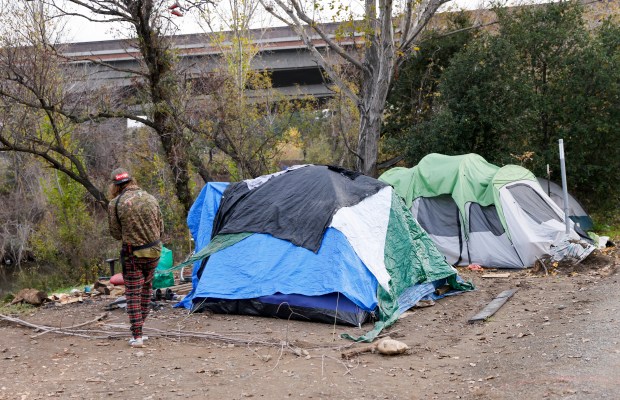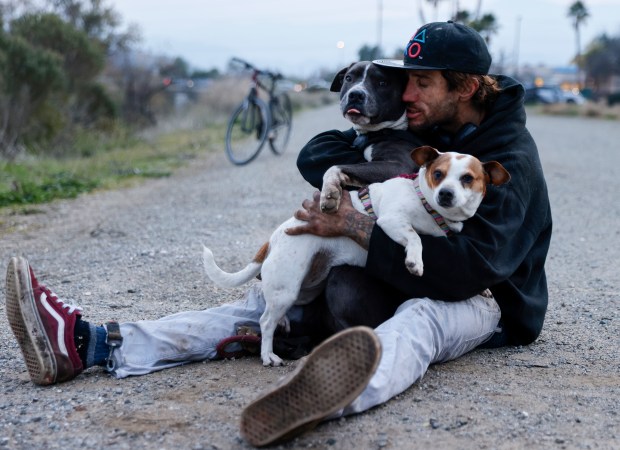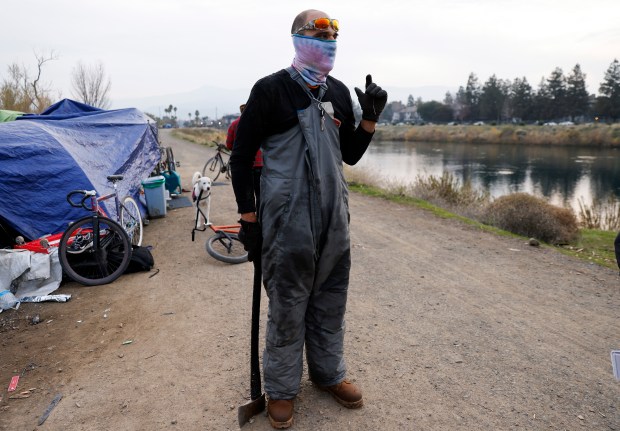Claudine Sipili works for one of the Bay Area’s leading organizations battling homelessness and used to be homeless herself, so she knows how to answer when somebody asks: What can I do to really help somebody living on the street this winter?
She knows that handing out hats and blankets helps — but leaving big boxes of perishable food at an encampment does not. She knows an effective way to always be ready to help is carrying a supply of cold-weather items in your car. That way, when you encounter someone on the street, you can stop and ask if they need something.
With the holidays upon us and the Bay Area’s homelessness epidemic getting worse, we asked a dozen unhoused people and advocates for the best — and worst — ways to help our neighbors who have no choice but to spend the festive season in tents, vehicles and shacks. Here’s their advice:
Give items that help people stay warm and dry
Staying warm and keeping out of the rain is the number-one priority for most unhoused people this time of year. Temperatures have dipped in the Bay Area in recent weeks, and rain has made it even more difficult to live outside.
“If I stick anything out of my sleeping bag it’s frozen to the touch sometimes at night when it gets really cold,” said Jaz Colibri, who lives in her car in an encampment on Wood Street in West Oakland.
Socks, hats, gloves, jackets and other warm clothing are in high demand at encampments, as are blankets — including mylar thermal blankets. Tents and tarps to keep out the rain are useful, as recent storms have destroyed many people’s tents. Hand warmer packets help too, as do warm drinks like coffee.

Food and water
Soup in pull-top containers and instant noodle cups are popular in encampments because they don’t require can openers or much preparation to eat, said Shaunn Cartwright, a longtime activist who delivers meals and other supplies to encampments throughout San Jose. And people always need bottled water.
But don’t leave food unless you’re sure someone will eat it
Too often well-meaning people or businesses with leftover food will drop off large quantities of perishable items at encampments without checking first to see if anyone at the camp wants it. If it’s too much food, or if it’s items people don’t like or can’t eat (many unhoused people have diabetes and other health conditions) it ends up a problem rather than a solution.
“If you don’t have a trash bin, anything left over will rot and the rats will come,” said Andrea Henson, an East Bay attorney who advocates for and represents unhoused people.
Even worse, sometimes people donate expired food they want to get rid of, Henson said. That’s never helpful.
It’s the same with clothing and other items — make sure it will be used. For example, if you bring children’s clothing to an encampment with no children, those clothes will end up adding to the camp’s trash problem.

Smile and say hi
The best way to find out what someone needs is to ask. And even if you’re not in a position to donate, a smile and a friendly greeting or conversation can go a long way.
When Evan Sidor says hi to people walking by, they often ignore him or seem afraid. It makes 28-year-old Sidor, who lives in an encampment behind Bass Pro Shops in San Jose, feel like “trash.”
“I don’t remember the last time I said hi and someone said ‘Hi, how are you?’” he said.

Don’t take pictures without permission
Sometimes do-gooders handing out clothes or food at encampments want to take pictures to document the experience, and they’ll start snapping away without asking first, Henson said.
“They’re providing a kindness,” Henson said, “but they also have to respect that that’s a human being who wants to be respected and they should ask permission.”
Light
It gets dark at night in an encampment, so flashlights and headlamps are appreciated. Many people already have flashlights and headlamps but could use fresh AA and AAA batteries to keep them running.
A good bike lock
Unhoused people often use bicycles as their main mode of transportation. A heavy-duty U-lock can help keep their bike safe while they run errands, apply for jobs or do whatever else they need to do.
Pet supplies
Encampments are full of animal companions keeping their owners company on cold, lonely nights and offering protection from the dangers of living on the street. Food, beds, flea medicine and toys for dogs and cats can come in handy.

Should you give cash?
Sipili gives cash to people in need because it lifts their spirits and allows them to buy exactly what they need, she said.
But if someone is struggling with substance abuse, does giving cash — which can be spent on alcohol or drugs — hurt more than it helps? That’s something she’s grappled with, she said. If you’re going to give cash, you have to accept that once the money leaves your hands, you have no control over how it is used.
“They’re going to spend it however they want to spend it,” said Sipili, who once spent a year and a half bouncing between her car, the street and a women’s shelter and now is the director of lived experience and innovation for Santa Clara County-based Destination: Home.
If you feel uncomfortable giving cash, bus tokens and passes or gift cards to nearby establishments are a helpful alternative.
Offer work
Many unhoused people would like to work for pay, and some come from backgrounds in construction and have their own tools, said 33-year-old Trever Vargas, who lives in the Bass Pro Shops encampment. Do you have some manual labor you need done?
“None of us are shy of working,” he said.

Connect people to services
There is a notorious lack of housing and shelter for people who are homeless in the Bay Area. But there are resources you can share that can help people in need find a warming center or get on a waitlist for housing.
In Santa Clara County, they can call the “Here4You” hotline at 408-385-2400. In the rest of the Bay Area, people can call 211 for help.
You can also donate warm clothing, blankets and other in-demand items to local outreach agencies such as Where Do We Go Berkeley in the East Bay, LifeMoves and HomeFirst in Santa Clara County and Samaritan House in San Mateo County.
Source: www.mercurynews.com
